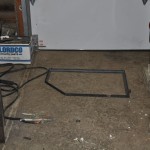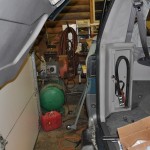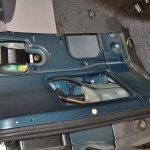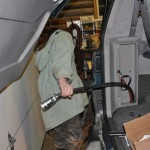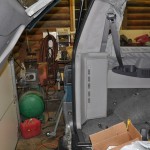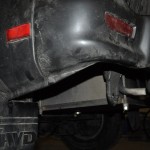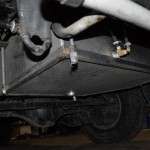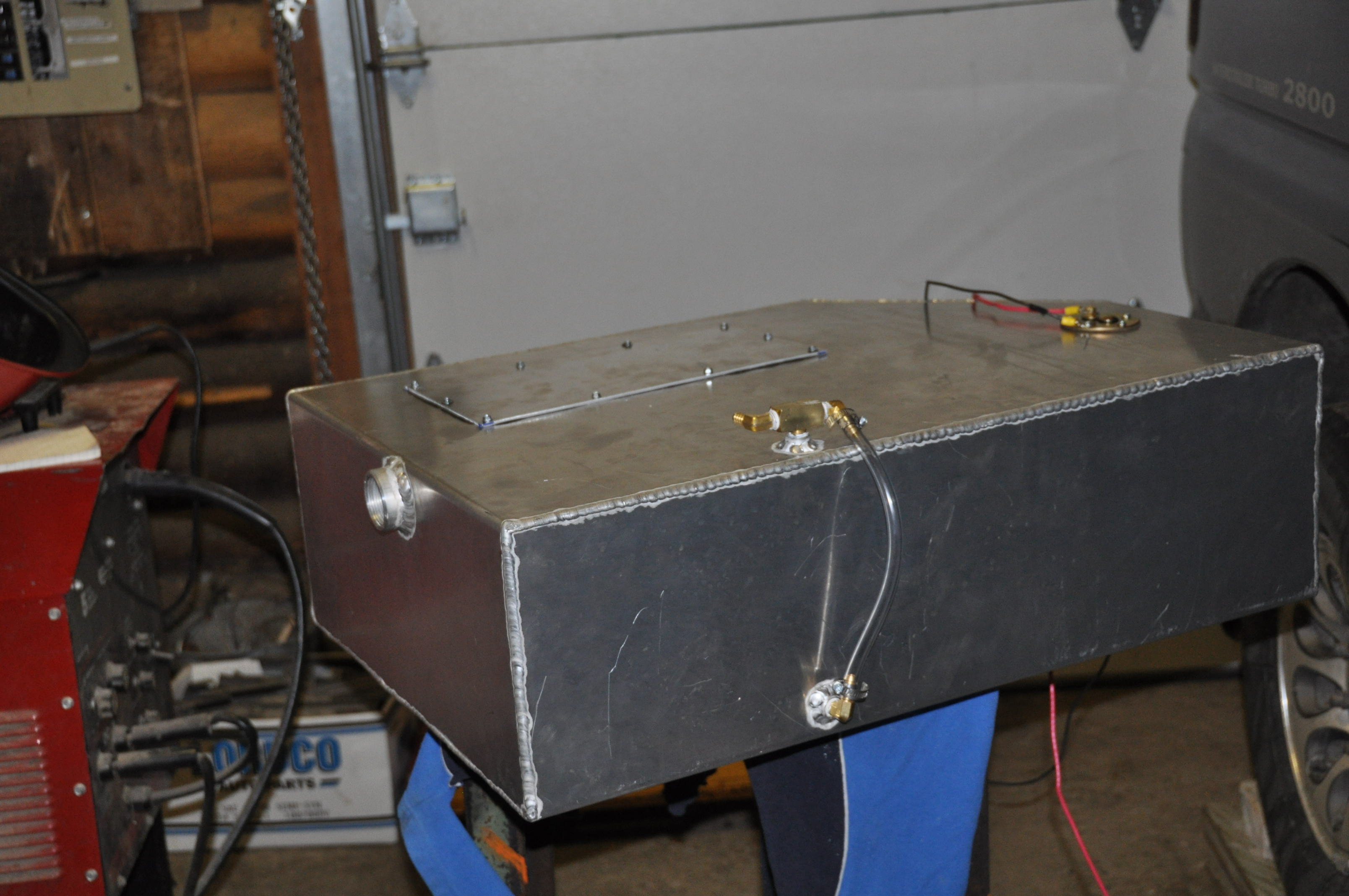
I’d thought I would do an introductory post on WVO (waste vegetable oil) conversions generally, but I have been working on the fuel tank recently so I guess I am going to post on that …
The typical automotive diesel engine is not setup to use oil as fuel; if you were to try to run the engine on oil with no modifications it would quickly fail. The cold, heavy, viscous oil will clog the injector pump and foul the injectors. In order for the engine to work with oil, the oil needs to be heated. The heated oil has a lower viscosity, allowing it to flow better and pass through the injectors without clogging. A two tank system is typically used; the engine is started on the first tank (the original diesel tank), and when the engine has warmed up enough to heat the oil it is switched over to the second (waste vegetable oil) tank. Before the engine is shut down it is switched back to the diesel tank so that the oil can be purged (by diesel) out of the fuel lines and engine so that when the engine is started later it will not be clogged with cold, viscous oil.
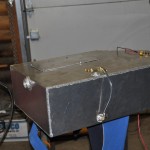 So, in order to do a two tank WVO conversion you need to add a tank to your vehicle. There are lots of options on how to do this … we decided to add an aluminum tank underneath the vehicle where the spare tire is normally kept on a Delica. Lots of Delica conversions have been done and this is a fairly common location for the second tank. In fact, it is so common that there are even a few people making tanks that fit in this location. I got in touch with Andrew Horvath through www.delica.ca and he built us an aluminum tank (9″ x 19.5″ x 30″). The tank is aluminum with brass and plastic fittings so that there is no
So, in order to do a two tank WVO conversion you need to add a tank to your vehicle. There are lots of options on how to do this … we decided to add an aluminum tank underneath the vehicle where the spare tire is normally kept on a Delica. Lots of Delica conversions have been done and this is a fairly common location for the second tank. In fact, it is so common that there are even a few people making tanks that fit in this location. I got in touch with Andrew Horvath through www.delica.ca and he built us an aluminum tank (9″ x 19.5″ x 30″). The tank is aluminum with brass and plastic fittings so that there is no
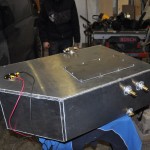 reaction between the tank material and the oil.
reaction between the tank material and the oil.
The tank we used was originally designed to fit a Delica L300 but has also been used successfully for L400 conversions, although some modifications are required to route the exhaust around the tank. Many people choose to modify the exhaust; either routing it around the tank and out the back, or converting to a side exhaust. We have a short wheel base (SWB) Delica and my understanding is that if you have an LWB (long wheel base) Delica fitting the tank is fairly simple without significant modifications. I decided to have the corner cut off of the tank (the non-rectangular shape is not standard) so that the exhaust did not have to be changed.
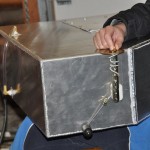 The tank comes with an aluminum heating coil in the tank (the two side-by-side barbed fittings are the ends of it) that allows you to run engine coolant through the tank to warm the oil. The tank is also provided with fittings for a site tube so you can see the oil level, a fitting for the fuel line to the injector pump and a filler fitting on the side. It also had a breather fitting that got cut off so I tee’d the top site tube fitting and ran my breather hose there. I also installed a fuel level sending unit, which involved drilling a hole in the top of the tank and mounting it. I drilled the hole upside down to try and minimize shavings in the tank, and then spent some time making sure it was clean.
The tank comes with an aluminum heating coil in the tank (the two side-by-side barbed fittings are the ends of it) that allows you to run engine coolant through the tank to warm the oil. The tank is also provided with fittings for a site tube so you can see the oil level, a fitting for the fuel line to the injector pump and a filler fitting on the side. It also had a breather fitting that got cut off so I tee’d the top site tube fitting and ran my breather hose there. I also installed a fuel level sending unit, which involved drilling a hole in the top of the tank and mounting it. I drilled the hole upside down to try and minimize shavings in the tank, and then spent some time making sure it was clean.
The tank sits in a steel angle iron cradle that is bolted to the frame of the van with 1/2″ threaded steel rod. Andrew made the cradle, but I re-welded some of the fittings after the tank was modified and I also welded the 1/2″ mounting brackets.
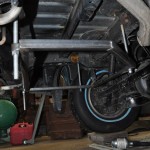 The coolant lines (3/4″) are tee’d from the coolant lines running to/from the rear heater in the van. The fuel line runs to the electric valve I installed in the engine compartment that feeds the injection pump. I bundled the lines together so that the coolant lines heat the fuel line and help the oil to flow. The fuel line is 1/2″ diameter to the WVO filter I installed in the engine compartment; the large diameter hopefully makes it easier for the pump to move the viscous oil.
The coolant lines (3/4″) are tee’d from the coolant lines running to/from the rear heater in the van. The fuel line runs to the electric valve I installed in the engine compartment that feeds the injection pump. I bundled the lines together so that the coolant lines heat the fuel line and help the oil to flow. The fuel line is 1/2″ diameter to the WVO filter I installed in the engine compartment; the large diameter hopefully makes it easier for the pump to move the viscous oil.
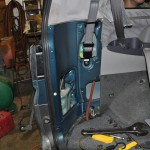 The 1/4″ breather line and the 3/4″ filler line run through holes I drilled through the floor of the van into a small compartment at the rear passenger side of the vehicle. I over-sized the hole for the filler line so that I could mount a bulkhead fitting for this line going through the floor (I used a relatively inexpensive irrigation fitting)… this was pretty excessive but I did not want this line rubbing and failing over time.
The 1/4″ breather line and the 3/4″ filler line run through holes I drilled through the floor of the van into a small compartment at the rear passenger side of the vehicle. I over-sized the hole for the filler line so that I could mount a bulkhead fitting for this line going through the floor (I used a relatively inexpensive irrigation fitting)… this was pretty excessive but I did not want this line rubbing and failing over time.
I cut a hole in the plastic body panel so that these lines run into the small side compartment and are not visible if the compartment is closed. I ran the breather line up into the side panel of the vehicle. I wanted the breather opening up high, out of the way, in a clean locati
on and not inside the vehicle … this location seemed to fit the bill. The filler line is about 3′ long and terminates in a 3/4″ female hydraulic quick connect. The pump used to fill the tank will be fitted with a matching male fitting, and should make filling the tank fairly simple and clean. In situations where I am trying to pour in filtered oil I will probably setup a funnel with another matching connector … it will be slow with a 3/4″ line but I do not anticipate filling the tank without the pump anyways.
